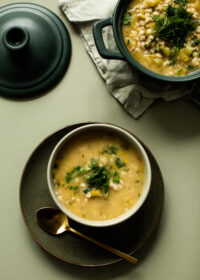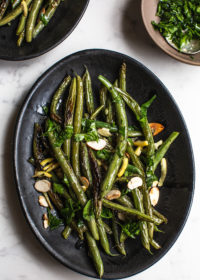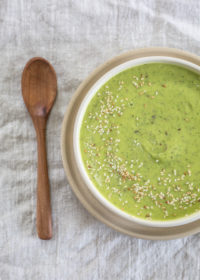Recipes: Sesame Kale Salad + Macrobiotics 101
 “There are many roads to the table.”
“There are many roads to the table.”
As you know, my food philosophy tends to blend Ayurveda, macrobiotics and living foods in a seasonal approach. The fundamental principles of these three practices are:
- Eat the freshest, naturally-grown, seasonal produce in their peak nutrition
- Choose food from local and regional sources
- Prepare food in a loving way that promotes balance, harmony and health
Each system emphasizes using whole foods to gain more energy. The intelligence of whole foods lies in the natural intelligence of plants. Using energy from sunlight, plants transform inorganic nutrients into organic bioavailable nutrients. The complex spectrum of macronutrients – protein, fat, and carbohydrates – and micronutrients – vitamins, minerals, and phytonutrients – is soundly represented in the abundant mix of whole foods. Nutrients are designed to function in a synergistic relationship with one another. All three also focus on the balance of flavors to accomplish harmony in the body and mind.


Macrobiotics takes a big, long view of life in relationship to nature. The meaning is derived from the Greek word “macro”, meaning “big, large, long”, and “bio” meaning “life”. The macrobiotic philosophy seeks to live a long, fulfilled life by living in harmony with nature and eating a simple, balanced diet. Like the Ayurvedic system, balance is the key to health and happiness. One of the driving factors of the macrobiotic system of balance is the quality of food and flavors. Food is the fundamental and primary medicine to bring the body in balance.
The principles of macrobiotics originated in the 19th century by a physician named Sagen Ishisuka. Dr. Ishisuka established the theory of nutrition and medicine based on applying the Western medical science of medicine, biology, chemistry, and physiology to traditional Oriental medicine. His diet and nutrition knowledge stems from the traditional Japanese diet, and is radically against the standards of European dairy, meat and refined foods. His primary food philosophy is based on these principles:
- Food is the basis of health, happiness and a long life.
- The best food is natural, whole and unrefined
- The best food is locally grown and eaten in season
- Sodium and potassium in food are the most important antagonistic and complementary elements for the harmony of yin and yang in the body.
The concept of Yin and Yang describes two primal opposing yet complementary forces that govern life and the universe. Just as foods in Ayurvedic nutrition contain the different qualities of vata, pitta, and kapha – the Macrobiotic nutrition system uses Yin and Yang to classify foods. Yin foods have a cold, damp, expansive and sweet nature. Yang foods have a hot, dry, contractive, and salty nature. Macrobiotic nutrition focuses on achieving harmony between these two natural forces of yin and yang. The ideal diet is based on foods with a natural balance of yin and yang, like vegetables and grains. The aim is to cultivate a dependable balance by keeping a moderation of extreme flavors and temperatures.

- Less Is More – moderate use of oil, salt, seasoning and heat.
- Balance of Flavors – avoid foods that are extremely sour, salty, sweet, spicy, bitter can be harshly stimulating to the body and can act as a stressor that throws the body off in its efforts to maintain equilibrium.
- Moderate Temperatures – foods that are extreme in temperature of overly hot or freezing cold shock the internal system when eaten quickly. Additionally, high-temperature cooking and freezing can be destructive to the foods enzymes and nutrient content.
- Whole, Natural Foods – avoid processed foods, use unrefined whole foods including seasonal vegetables, fruits, grains and legumes. Avoid highly refined seasonings or dressings and use naturally made condiments.
- Peaceful Atmosphere –mindful preparation of food should be done in a quiet and peaceful environment, never cook when stressed, angry, tired, or distracted.
Five Tastes of Macrobiotics
“The macrobiotic way of life is based on achieving and maintaining a dynamic balance with our environment in nature and the universe, beginning most fundamentally with the proper selection and preparation of our daily foods.” –Wendy Esko, ‘Macrobiotic for Life’
| Sour | Salty | Sweet | Pungent/Spicy | Bitter |
| -Apple cider vinegar
-Brown rice vinegar -Lemon -Pickles -Sauerkraut -Shiso leaves -Umeboshi plum paste/vinegar |
-Gomasio (ground roasted sesame seeds and salt)
-Miso -Sea salt -Seaweed -Shiso leaves -Shoyu -Tamari -Umeboshi plum paste/vinegar |
-Amasake
-Apple -Barley malt syrup -Brown rice syrup -Butternut squash -Carrot -Kabocha squash -Sweet potato -Parsley |
-Arugula
-Daikon -Ginger -Green onions/scallions -Onions -Radishes -Watercress |
-Dandelion
-Green nori -Gomasio (ground roasted sesame seeds and salt) -Wakame |
This salad carefully balances the flavors used in common macrobiotic cooking. The vinaigrette, which is a blend of umeboshi plum (pickled Japanese plums) paste and vinegar, tamari (wheat-free soy sauce), lime juice and sesame oil, adds a complexity of flavors (umami) alongside the crunchy textured salad of chopped bitter kale, sweet red cabbage and baby bok choy, and salty sea vegetables of dulse and nori. You can enjoy this on it’s own for a light-but-satiating summer salad, or serve alongside a big scoop of warm brown rice, adzuki beans, and mashed sweet potato or sautéed carrots for a complete macrobiotic meal.


Ume Vinaigrette
1/2 cup toasted sesame oil
2 tbsp tamari
3 tbsp ume plum vinegar
1/2 tsp ume plum paste
2 limes, juiced
1 tbsp water
Whisk together all the ingredients in a small bowl. Pour over top salad and toss well before serving.
Chopped Salad
1 bunch kale, stems removed & finely chopped
1/2 head red cabbage, finely chopped
2 bunches baby bok choy, trimmed & finely chopped
1 bunch cilantro, stems removed & finely chopped
2 sheets nori
1/4 cup dulse flakes
2 tbsp sesame seeds
Combine all ingredients a large mixing bowl. Toss with salad dressing, cover and store in the fridge for 30 minutes to marinate before serving. When ready to eat, enjoy with an avocado or serve over top warm brown rice.
Makes 4 servings
 [wpmenucart]
[wpmenucart]


